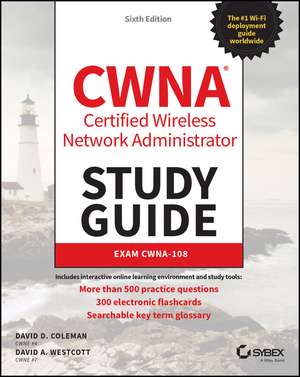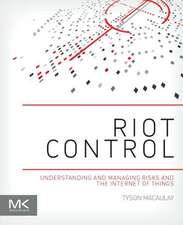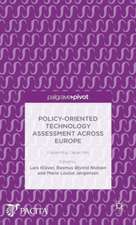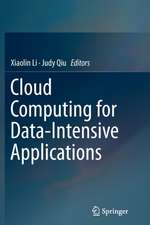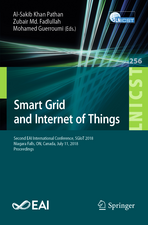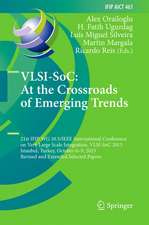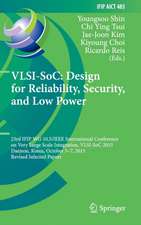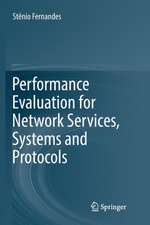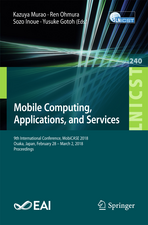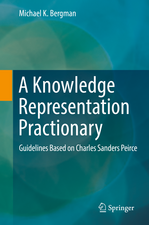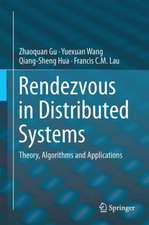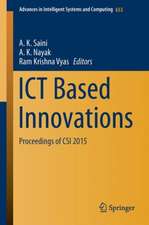CWNA – Certified Wireless Network Administrator Study Guide – Exam CWNA–108, 6th Edition: Sybex Study Guide
Autor DD Colemanen Limba Engleză Paperback – 29 apr 2021
The CWNA: Certified Wireless Network Administrator Study Guide is the ultimate preparation resource for the CWNA exam. Fully updated to align with the latest version of the exam, this book features expert coverage of all exam objectives to help you pass the exam. But passing the exam is just a first step. For over 16 years, the CWNA Study Guide has helped individuals jump-start their wireless networking careers. Wireless networking professionals across the globe use this book as their workplace reference guide for enterprise Wi-Fi technology.
Owning this book provides you with a foundation of knowledge for important Wi-Fi networking topics, including:
- Radio frequency (RF) fundamentals
- 802.11 MAC and medium access
- Wireless LAN topologies and architecture
- WLAN design, troubleshooting and validation
- Wi-Fi networking security
The CWNA certification is a de facto standard for anyone working with wireless technology. It shows employers that you have demonstrated competence in critical areas, and have the knowledge and skills to perform essential duties that keep their wireless networks functioning and safe. The CWNA: Certified Wireless Network Administrator Study Guide gives you everything you need to pass the exam with flying colors.
Din seria Sybex Study Guide
- 20%
 Preț: 206.41 lei
Preț: 206.41 lei - 20%
 Preț: 204.48 lei
Preț: 204.48 lei -
 Preț: 416.00 lei
Preț: 416.00 lei - 20%
 Preț: 204.15 lei
Preț: 204.15 lei -
 Preț: 260.98 lei
Preț: 260.98 lei - 20%
 Preț: 272.31 lei
Preț: 272.31 lei - 20%
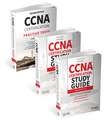 Preț: 467.73 lei
Preț: 467.73 lei - 20%
 Preț: 343.55 lei
Preț: 343.55 lei - 20%
 Preț: 205.15 lei
Preț: 205.15 lei - 20%
 Preț: 289.39 lei
Preț: 289.39 lei - 20%
 Preț: 272.52 lei
Preț: 272.52 lei -
 Preț: 322.04 lei
Preț: 322.04 lei - 20%
 Preț: 304.03 lei
Preț: 304.03 lei -
 Preț: 351.33 lei
Preț: 351.33 lei -
 Preț: 404.31 lei
Preț: 404.31 lei - 20%
 Preț: 175.26 lei
Preț: 175.26 lei -
 Preț: 325.22 lei
Preț: 325.22 lei -
 Preț: 288.65 lei
Preț: 288.65 lei -
 Preț: 383.42 lei
Preț: 383.42 lei - 20%
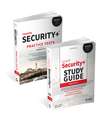 Preț: 399.67 lei
Preț: 399.67 lei - 8%
 Preț: 439.49 lei
Preț: 439.49 lei -
 Preț: 427.34 lei
Preț: 427.34 lei - 8%
 Preț: 365.37 lei
Preț: 365.37 lei - 8%
 Preț: 441.16 lei
Preț: 441.16 lei - 20%
 Preț: 274.58 lei
Preț: 274.58 lei -
 Preț: 322.04 lei
Preț: 322.04 lei -
 Preț: 413.10 lei
Preț: 413.10 lei - 20%
 Preț: 298.46 lei
Preț: 298.46 lei - 20%
 Preț: 274.41 lei
Preț: 274.41 lei -
 Preț: 257.90 lei
Preț: 257.90 lei - 20%
 Preț: 289.18 lei
Preț: 289.18 lei - 20%
 Preț: 221.90 lei
Preț: 221.90 lei - 20%
 Preț: 411.29 lei
Preț: 411.29 lei - 20%
 Preț: 276.82 lei
Preț: 276.82 lei - 20%
 Preț: 278.23 lei
Preț: 278.23 lei -
 Preț: 326.42 lei
Preț: 326.42 lei - 20%
 Preț: 224.78 lei
Preț: 224.78 lei -
 Preț: 294.97 lei
Preț: 294.97 lei -
 Preț: 291.72 lei
Preț: 291.72 lei -
 Preț: 321.94 lei
Preț: 321.94 lei - 20%
 Preț: 281.57 lei
Preț: 281.57 lei - 20%
 Preț: 251.37 lei
Preț: 251.37 lei -
 Preț: 324.94 lei
Preț: 324.94 lei - 20%
 Preț: 308.58 lei
Preț: 308.58 lei -
 Preț: 432.33 lei
Preț: 432.33 lei -
 Preț: 407.96 lei
Preț: 407.96 lei - 20%
 Preț: 289.14 lei
Preț: 289.14 lei -
 Preț: 340.55 lei
Preț: 340.55 lei - 20%
 Preț: 280.68 lei
Preț: 280.68 lei
Preț: 309.99 lei
Preț vechi: 387.49 lei
-20% Nou
Puncte Express: 465
Preț estimativ în valută:
59.32€ • 63.43$ • 49.46£
59.32€ • 63.43$ • 49.46£
Carte disponibilă
Livrare economică 27 martie-10 aprilie
Livrare express 13-19 martie pentru 79.38 lei
Preluare comenzi: 021 569.72.76
Specificații
ISBN-13: 9781119734505
ISBN-10: 1119734509
Pagini: 1088
Dimensiuni: 187 x 235 x 57 mm
Greutate: 1.75 kg
Ediția:6th Edition
Editura: Sybex
Seria Sybex Study Guide
Locul publicării:Hoboken, United States
ISBN-10: 1119734509
Pagini: 1088
Dimensiuni: 187 x 235 x 57 mm
Greutate: 1.75 kg
Ediția:6th Edition
Editura: Sybex
Seria Sybex Study Guide
Locul publicării:Hoboken, United States
Notă biografică
DAVID D. COLEMAN, CWNE #4, David D. Coleman, CWNE #4, is a technology evangelist and public speaker who specializes in Wi-Fi and cloud technologies. David is also Director of Product Marketing for Extreme Networks. He is the author of numerous books, white papers and videos about Wi-Fi technology. DAVID A. WESTCOTT, CWNE #7, is an independent consultant and WLAN technical trainer of thirty years. He provides vendor and custom wireless training to government agencies, corporations and universities around the world.
Cuprins
Foreword xxxv Introduction xxxvii Assessment Test lvi Chapter 1 Overview of Wireless Standards, Organizations, and Fundamentals 1 History of Wireless Local Area Networks 3 Standards Organizations 5 Federal Communications Commission 5 International Telecommunication Union Radiocommunication Sector 6 Institute of Electrical and Electronics Engineers 8 Internet Engineering Task Force 9 Wi-Fi Alliance 11 International Organization for Standardization 21 Core, Distribution, and Access 22 Communications Fundamentals 24 Communication Terminology 24 Understanding Carrier Signals 25 Understanding Keying Methods 27 Summary 33 Exam Essentials 33 Review Questions 34 Chapter 2 IEEE 802.11 Standard and Amendments 39 Original IEEE 802.11 Standard 42 IEEE 802.11-2020 Ratified Amendments 44 802.11a-1999 45 802.11b-1999 46 802.11d-2001 47 802.11e-2005 47 802.11g-2003 48 802.11h-2003 50 802.11i-2004 52 802.11j-2004 53 802.11k-2008 53 802.11n-2009 54 802.11p-2010 55 802.11r-2008 55 802.11s-2011 56 802.11u-2011 57 802.11v-2011 58 802.11w-2009 58 802.11y-2008 59 802.11z-2010 59 802.11aa-2012 59 802.11ac-2013 59 802.11ad-2012 60 802.11ae-2012 61 802.11af-2014 61 802.11ah-2016 62 802.11ai-2016 63 802.11aj-2018 63 802.11ak-2018 63 802.11aq-2018 63 IEEE 802.11 Draft Amendments 63 802.11ax (High Efficiency) 64 802.11ay (Next-Generation 60 GHz) 65 802.11az (Next-Generation Positioning) 65 802.11ba (Wake-Up Radio) 65 802.11bb (Light Communications) 65 802.11bc (Enhanced Broadcast Service) 65 802.11bd (Enhancements for Next-Generation V2X) 65 802.11be (Extremely High Throughput) 66 Defunct Amendments 66 802.11F 66 802.11T 67 IEEE Task Group m 68 Summary 69 Exam Essentials 69 Review Questions 70 Chapter 3 Radio Frequency Fundamentals 75 What is a Radio Frequency Signal? 77 Radio Frequency Characteristics 78 Wavelength 78 Frequency 83 Amplitude 85 Phase 86 Radio Frequency Behaviors 87 Wave Propagation 87 Absorption 88 Reflection 89 Scattering 91 Refraction 91 Diffraction 92 Loss (Attenuation) 94 Free Space Path Loss 96 Multipath 98 Gain (Amplification) 101 RF Analysis Tools 102 Summary 103 Exam Essentials 103 Review Questions 104 Chapter 4 Radio Frequency Components, Measurements, and Mathematics 109 Components of RF Communications 112 Transmitter 112 Antenna 113 Receiver 114 Intentional Radiator 114 Equivalent Isotropically Radiated Power 114 Units of Power and Comparison 115 Watt 116 Milliwatt 117 Decibel 117 Decibels Relative to an Isotropic Radiator (dBi) 120 Decibels Relative to a Half-Wave Dipole Antenna (dBd) 120 Decibels Relative to 1 Milliwatt (dBm) 121 Inverse Square Law 122 RF Mathematics 123 Rule of 10s and 3s 124 RF Math Summary 129 Noise Floor 130 Signal-to-Noise Ratio 130 Signal-to-Interference-Plus-Noise Ratio 131 Received Signal Strength Indicator 131 Link Budget 135 Fade Margin/System Operating Margin 138 Summary 140 Exam Essentials 142 Review Questions 143 Chapter 5 Radio Frequency Signal and Antenna Concepts 147 Azimuth and Elevation Charts (Antenna Radiation Envelopes) 150 Interpreting Polar Charts 152 Beamwidth 155 Antenna Types 157 Omnidirectional Antennas 158 Downtilt Omnidirectional Antennas 161 Semidirectional Antennas 162 Highly Directional Antennas 164 Sector Antennas 166 Antenna Arrays 167 Visual Line of Sight 169 RF Line of Sight 169 Fresnel Zone 170 Earth Bulge 174 Antenna Polarization 175 Antenna Diversity 176 Multiple-Input, Multiple-Output 177 MIMO Antennas 178 Antenna Connection and Installation 179 Voltage Standing Wave Ratio 179 Signal Loss 181 Antenna Mounting 181 Antenna Accessories 187 Cables 188 Connectors 188 Splitters 189 Amplifiers 189 Attenuators 190 Lightning Arrestors 191 Grounding Rods and Wires 192 Regulatory Compliance 192 Summary 194 Exam Essentials 194 Review Questions 195 Chapter 6 Wireless Networks and Spread Spectrum Technologies 199 Throughput vs. Bandwidth 201 Narrowband and Spread Spectrum 202 Multipath Interference 204 Frequency-Hopping Spread Spectrum 205 Hopping Sequence 206 Dwell Time 207 Hop Time 207 Modulation 207 Direct-Sequence Spread Spectrum 208 DSSS Data Encoding 208 Modulation 209 Transmit Spectrum Mask 210 Orthogonal Frequency-Division Multiplexing 211 Convolutional Coding 212 Modulation 213 Transmit Spectrum Mask 215 Orthogonal Frequency-Division Multiple Access 217 Industrial, Scientific, and Medical Bands 218 900 MHz ISM Band 218 2.4 GHz ISM Band 219 5.8 GHz ISM Band 219 5 GHz Unlicensed National Information Infrastructure Bands 220 U-NII-1 220 U-NII-2A 221 U-NII-2C 221 U-NII-3 222 U-NII-4 222 60 GHz for Wi-Fi 223 Below 1 GHz 224 2.4 GHz Channels 224 5 GHz Channels 227 Long-Term Evolution in 5 GHz 231 6 GHz Channels 232 6 GHz Incumbents 235 Automated Frequency Coordination 236 6 GHz Worldwide 237 6 GHz Wi-Fi Considerations 238 Summary 239 Exam Essentials 239 Review Questions 240 Chapter 7 Wireless LAN Topologies 245 Wireless Networking Topologies 247 Wireless Wide Area Network 248 Wireless Metropolitan Area Network 248 Wireless Personal Area Network 249 Wireless Local Area Network 250 802.11 Stations 251 Client Station 252 Access Point Station 252 Integration Service 252 Distribution System 253 Wireless Distribution System 254 802.11 Service Sets 255 Service Set Identifier 256 Basic Service Set 256 Basic Service Area 257 Basic Service Set Identifier 258 Multiple Basic Service Set Identifiers 259 Extended Service Set 261 Independent Basic Service Set 262 Personal Basic Service Set 264 Mesh Basic Service Set 264 QoS Basic Service Set 266 802.11 Configuration Modes 267 Access Point Modes 267 Client Station Modes 268 Summary 269 Exam Essentials 269 Review Questions 271 Chapter 8 802.11 Medium Access 275 CSMA/CA vs. CSMA/CD 276 Collision Detection 277 Distributed Coordination Function 278 Physical Carrier Sense 279 Virtual Carrier Sense 280 Pseudo-Random Backoff Timer 283 Interframe Space 285 Hybrid Coordination Function 286 Enhanced Distributed Channel Access 287 HCF Controlled Channel Access 288 Wi-Fi Multimedia 288 Airtime Fairness 290 Summary 292 Exam Essentials 292 Review Questions 293 Chapter 9 802.11 MAC 297 Packets, Frames, and Bits 299 Data-Link Layer 300 MAC Service Data Unit 300 MAC Protocol Data Unit 300 Physical Layer 301 PLCP Service Data Unit 301 PLCP Protocol Data Unit 302 802.11 and 802.3 Interoperability 302 802.11 MAC Header 303 Frame Control Field 304 Duration/ID Field 306 MAC Layer Addressing 307 Sequence Control Field 314 QoS Control Field 315 HT Control Field 315 802.11 Frame Body 315 802.11 Trailer 316 802.11 State Machine 317 Management Frames 318 Beacon 318 Authentication 325 Association 326 Reassociation 329 Disassociation 331 Deauthentication 331 Action Frame 331 Control Frames 333 ACK Frame 333 Block Acknowledgment 335 PS-Poll 336 RTS/CTS 336 CTS-to-Self 338 Protection Mechanisms 338 Data Frames 341 QoS and Non-QoS Data Frames 342 Non-Data Carrying Frames 343 Power Management 344 Legacy Power Management 345 WMM-Power Save and U-APSD 347 MIMO Power Management 349 802.11ax Power Management 349 Summary 350 Exam Essentials 350 Review Questions 352 Chapter 10 MIMO Technology: HT and VHT 357 MIMO 360 Radio Chains 362 Spatial Multiplexing 363 MIMO versus SISO diversity 366 Maximal Ratio Combining 366 Space-Time Block Coding 367 Cyclic Shift Diversity 368 Transmit Beamforming 368 Explicit Beamforming 370 Multi-User MIMO 371 Multi-User Beamforming 373 Channels 376 20 MHz Channels 376 40 MHz Channels 377 Forty MHz Intolerant 379 80 MHz and 160 MHz Channels 380 Guard Interval 382 256-QAM Modulation 384 802.11n/ac PPDUs 388 Non-HT 388 HT Mixed 388 VHT 389 802.11n/ac MAC 390 A-MSDU 390 A-MPDU 391 Block Acknowledgment 392 Power Management 392 Modulation and Coding Scheme 394 802.11ac Data Rates 397 HT/VHT Protection Mechanisms 399 HT Protection Modes (0-3) 399 Wi-Fi Alliance Certification 400 Summary 403 Exam Essentials 403 Review Questions 405 Chapter 11 WLAN Architecture 409 WLAN Client Devices 411 802.11 Radio Form Factors 412 802.11 Radio Chipsets 418 Client Utilities 418 Management, Control, and Data Planes 421 Management Plane 422 Control Plane 422 Data Plane 423 WLAN Architecture 423 Autonomous WLAN Architecture 423 Centralized Network Management Systems 425 Centralized WLAN Architecture 427 Distributed WLAN Architecture 434 Hybrid WLAN Architecture 436 Specialty WLAN Infrastructure 437 Enterprise WLAN Branch Routers 437 WLAN Mesh Access Points 438 WLAN Bridges 439 Real-Time Location Systems 441 VoWiFi 443 Cloud Networking 445 Application Programming Interface 448 Transport and Data Formats 449 WLAN APIs 450 Common Applications 450 Infrastructure Management 451 Protocols for Management 452 Summary 456 Exam Essentials 457 Review Questions 458 Chapter 12 Power over Ethernet (PoE) 463 History of PoE 464 Nonstandard PoE 465 IEEE 802.3af 465 IEEE Std 802.3-2005, Clause 33 465 IEEE 802.3at-2009 465 IEEE Std 802.3-2018, Clause 33 466 IEEE 802.3bt-2018 466 PoE Devices 467 Powered Device 467 Power-Sourcing Equipment 469 Endpoint PSE 470 Midspan PSE 476 Planning and Deploying PoE 484 Power Planning 484 Redundancy 487 Downgrade PoE Capabilities 488 802.3bt Power Considerations 488 Summary 490 Exam Essentials 491 Review Questions 492 Chapter 13 WLAN Design Concepts 497 WLAN Coverage Design 499 Received Signal 500 Signal-to-Noise Ratio 501 Dynamic Rate Switching 503 Transmit Power 504 Roaming Design 505 Primary and Secondary Coverage 508 Fast Secure Roaming 509 Layer 3 Roaming 510 Channel Design 512 Adjacent Channel Interference 512 2.4 GHz Channel Reuse 513 Co-Channel Interference 516 5 GHz Channel Reuse 519 DFS Channels 521 40 MHz Channel Design 527 Static Channels and Transmit Power vs. Adaptive RF 529 Single-Channel Architecture 531 Capacity Design 534 High-Density 535 Band Steering 539 Load Balancing 542 Airtime Consumption 543 Voice vs. Data 546 Dual 5 GHz and Software-Defined Radios 548 6 GHz WLAN Design 551 Client Considerations 552 Coverage Considerations 553 6 GHz Channel Reuse 553 6 GHz AP Discovery 554 6 GHz Wi-Fi Security 556 Physical Environment 557 Antennas 558 Outdoor Design 562 Summary 563 Exam Essentials 564 Review Questions 565 Chapter 14 Site Survey and Validation 569 WLAN Site Survey and Design Interview 572 Customer Briefing 572 Business Requirements 573 Capacity and Coverage Requirements 574 Existing Wireless Network 576 Upgrading an Existing WLAN 577 Infrastructure Connectivity 578 Security Expectations 580 Guest Access 581 Aesthetics 581 Outdoor Surveys 582 Vertical Market Considerations 582 Government 583 Education 583 Healthcare 583 Retail 584 Warehouses and Manufacturing 584 Multi-Tenant Buildings 585 Legacy AP-on-a-Stick Survey 585 Spectrum Analysis 586 Coverage Analysis 590 Hybrid Survey 595 Initial Site Visit 595 Predictive Design 597 Validation Survey 599 Capacity and Throughput 601 Roaming 602 Delay and Jitter 603 Connectivity 603 Aesthetics 603 Site Survey Tools 604 Indoor Site Survey Tools 604 Outdoor Site Survey Tools 607 Documents and Reports 609 Forms and Customer Documentation 610 Deliverables 612 Additional Reports 613 Summary 614 Exam Essentials 615 Review Questions 616 Chapter 15 WLAN Troubleshooting 621 Five Tenets of WLAN Troubleshooting 623 Troubleshooting Best Practices 623 Troubleshoot the OSI Model 625 Most Wi-Fi Problems Are Client Issues 627 Proper WLAN Design Reduces Problems 628 WLAN Always Gets the Blame 629 Layer 1 Troubleshooting 629 WLAN Design 629 Transmit Power 630 RF Interference 630 Drivers 634 PoE 635 Firmware Bugs 635 Layer 2 Troubleshooting 636 Layer 2 Retransmissions 636 RF Interference 639 Low SNR 639 Adjacent Channel Interference 640 Hidden Node 641 Mismatched Power 646 Multipath 648 Security Troubleshooting 648 PSK Troubleshooting 649 802.1X/EAP Troubleshooting 651 VPN Troubleshooting 659 Roaming Troubleshooting 661 Channel Utilization 665 Layers 3-7 Troubleshooting 667 WLAN Troubleshooting Tools 671 WLAN Discovery Applications 671 Spectrum Analyzers 672 Protocol Analyzers 673 Throughput Test Tools 675 Standard IP Network Test Commands 677 Secure Shell 678 Summary 679 Exam Essentials 679 Review Questions 680 Chapter 16 Wireless Attacks, Intrusion Monitoring, and Policy 687 Wireless Attacks 688 Rogue Wireless Devices 689 Peer-to-Peer Attacks 692 Eavesdropping 693 Encryption Cracking 697 KRACK Attack 698 Kr00k Vulnerability 698 Authentication Attacks 699 MAC Spoofing 701 Management Interface Exploits 701 Wireless Hijacking 702 Denial-of-Service Attacks 703 Vendor-Specific Attacks 705 Social Engineering 706 Intrusion Monitoring 706 Wireless Intrusion Prevention System 706 Rogue Detection and Mitigation 709 Spectrum Analyzers 712 Wireless Security Policies 712 General Security Policies 713 Functional Security Policies 713 Legislative Compliance 714 802.11 Wireless Policy Recommendations 715 Summary 716 Exam Essentials 717 Review Questions 718 Chapter 17 802.11 Network Security Architecture 723 802.11 Security Basics 725 Data Privacy and Integrity 726 Authentication, Authorization, and Accounting 728 Segmentation 728 Monitoring and Policy 729 Legacy 802.11 Security 729 Legacy Authentication 730 Static WEP Encryption 731 MAC Filters 735 SSID Cloaking 735 Robust Security 736 Robust Security Network 737 Authentication and Authorization 738 PSK Authentication 738 Proprietary PSK Authentication 741 Simultaneous Authentication of Equals 743 802.1X/EAP Framework 746 EAP Types 749 Dynamic Encryption-Key Generation 751 4-Way Handshake 752 WLAN Encryption 754 TKIP Encryption 755 CCMP Encryption 756 GCMP Encryption 756 Management Frame Protection 757 WPA2 757 WPA3 758 WPA3-Personal 758 WPA3-Enterprise 759 Enhanced Open 761 6 GHz Wi-Fi Security 762 Traffic Segmentation 763 VLANs 763 RBAC 765 VPN Wireless Security 766 VPN 101 767 Layer 3 VPNs 768 SSL VPNs 768 VPN Deployment 768 Summary 770 Exam Essentials 770 Review Questions 772 Chapter 18 Bring Your Own Device (BYOD) and Guest Access 777 Mobile Device Management 780 Company-Issued Devices vs. Personal Devices 781 MDM Architecture 782 MDM Enrollment 784 MDM Profiles 788 MDM Agent Software 790 Over-the-Air Management 791 Application Management 793 Self-Service Device Onboarding for Employees 795 Dual-SSID Onboarding 796 Single-SSID Onboarding 796 MDM vs. Self-Service Onboarding 797 Guest WLAN Access 798 Guest SSID 798 Guest VLAN 799 Guest Firewall Policy 800 Captive Web Portals 801 Client Isolation, Rate Limiting, and Web Content Filtering 804 Guest Management 805 Guest Self-Registration 806 Employee Sponsorship 808 Social Login 809 Encrypted Guest Access 810 Hotspot 2.0 and Passpoint 811 Access Network Query Protocol 811 Hotspot 2.0 Architecture 813 802.1X/EAP and Hotspot 2.0 814 Online Sign-Up 815 Roaming Agreements 816 Network Access Control 816 Posture 817 OS Fingerprinting 818 AAA 820 RADIUS Change of Authorization 821 Single Sign-On 822 Summary 824 Exam Essentials 825 Review Questions 826 Chapter 19 802.11ax: High Efficiency (HE) 831 802.11ax = Wi-Fi 6 833 Wi-Fi Traffic Congestion 834 HE Overview 836 Multi-User 837 OFDMA 838 Subcarriers 839 Resource Units 840 Trigger Frames 844 Downlink OFDMA 847 Uplink OFDMA 848 Buffer Status Reports 849 Operating Mode Indication 850 MU-MIMO 851 BSS Color and Spatial Reuse 855 OBSS 855 BSS Color 857 Spatial Reuse Operation 858 Target Wake Time 861 Additional 802.11ax PHY and MAC Capabilities 862 1024-QAM 862 Long Symbol Time and Guard Intervals 863 802.11ax PHY headers 864 20 MHz-Only 865 Multi-TID AMPDU 867 Wi-Fi 6 Key Questions 867 Clients 867 Multi-Gig Ethernet 868 Power over Ethernet 870 4×4:4 vs. 8×8:8 871 80 MHz and 160 MHz Channels 872 Wi-Fi CERTIFIED 6 873 Summary 874 Review Questions 875 Chapter 20 WLAN Deployment and Vertical Markets 879 Deployment Considerations for Commonly Supported WLAN Applications and Devices 881 Data 881 Voice 882 Video 882 Real-Time Location Services 883 iBeacon Proximity 883 Mobile Devices 885 Corporate Data Access and End-User Mobility 885 Network Extension to Remote Areas 886 Bridging: Building-to-Building Connectivity 887 Wireless ISP: Last-Mile Data Delivery 888 Small Office/Home Office 888 Temporary Office Networking 889 Branch Offices 890 Teleworker Wi-Fi 890 Educational/Classroom Use 891 Industrial: Warehousing and Manufacturing 892 Retail 892 Healthcare 894 Municipal Networks 895 Hotspots: Public Network Access 895 Stadium Networks 897 Transportation Networks 897 Law Enforcement Networks 898 First-Responder Networks 899 Managed Service Providers 900 Fixed Mobile Convergence 900 WLAN and Health 901 Internet of Things 901 WLAN Vendors 902 Summary 904 Exam Essentials 904 Review Questions 905 Appendix A Answers to Review Questions 909 Chapter 1: Overview of Wireless Standards, Organizations, and Fundamentals 910 Chapter 2: IEEE 802.11 Standard and Amendments 911 Chapter 3: Radio Frequency Fundamentals 914 Chapter 4: Radio Frequency Components, Measurements, and Mathematics 915 Chapter 5: Radio Frequency Signal and Antenna Concepts 918 Chapter 6: Wireless Networks and Spread Spectrum Technologies 919 Chapter 7: Wireless LAN Topologies 922 Chapter 8: 802.11 Medium Access 924 Chapter 9: 802.11 MAC 926 Chapter 10: MIMO Technology: HT and VHT 929 Chapter 11: WLAN Architecture 932 Chapter 12: Power over Ethernet (PoE) 934 Chapter 13: WLAN Design Concepts 937 Chapter 14: Site Survey and Validation 940 Chapter 15: WLAN Troubleshooting 943 Chapter 16: Wireless Attacks, Intrusion Monitoring, and Policy 946 Chapter 17: 802.11 Network Security Architecture 948 Chapter 18: Bring Your Own Device (BYOD) and Guest Access 951 Chapter 19: 802.11ax: High Efficiency (HE) 954 Chapter 20: WLAN Deployment and Vertical Markets 957 Appendix B Abbreviations and Acronyms 961 Certifications 962 Organizations and Regulations 962 Measurements 963 Technical Terms 964 Index 981
